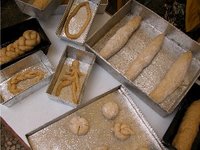Tea Bread Update and Sugar Bread Draft
As they say in Ghana, "Little by little, the chicken drinks water." The tea bread recipe is getting better and better. I've added some gluten flour, trimmed down the amount of yeast, and substituted ground mace for the nutmeg. I'm also using my electric bread maker to mix the dough (otherwise, just knead it).
Into the bread maker (or bowl), add (liquids first):
about 1 (8 oz.) cup warm water, and
2 oz margarine
Next, 1 lb. 1 oz. bread flour (I used Pillsbury this time), and
4 teaspoons gluten,
1 teaspoon salt
3/4 teaspoon ground mace
3/4 teaspoon dry powdered yeast
I set the timer on the "dough" setting, and wait for it to finish, then remove the dough, and put it in a greased bowl to sit for about 8 hours, then punch it down, shape it into a loaf or loaves with slightly tapered edges (I no longer use the bread pans), place it (them) on a lightly greased/oiled cookie sheet and let the dough rest for about half an hour (I always let my dough rise lightly covered with a dishtowel and rest in a slightly warmed oven with a bowl of water. Bake in a preheated oven at 375 degrees for about 45 minutes.
The picture above is actually from one of my earlier efforts and not the best illustration, but the better loaf got eaten before I could photograph it.
I"ve had another request for a sugar bread recipe (see the picture from the blog posting for March 5 to see various ways of shaping the bread besides in a bread pan). I don't believe in hoarding recipes, so even though I've not tested or developed this yet, here are my rough notes from my trip to Ghana (I'll probably halve this recipe as I work on it):
Sugar Bread, loaves and Rosca (working draft)
2 eggs
about 1/4 c full-cream powdered milk, or a single-serving sized packed (like Nido)
2 c sugar
7 c presifted flour (~2 1/2 lb)
2 t salt
4 heaping t ground nutmeg
3 level t yeast
12 oz margarine
1. Break 2 eggs into a large mixing bowl.
2. In a measuring cup add a single-serving-sized packet of full-cream powdered milk (a little less than 1/4 c) with enough water to make 1 c. Add the milk to the eggs along with 2 t salt and mix until foamy.
3. Add 2 c sugar and mix again.
4. In another bowl, measure out the flour and add 4 heaping teaspoons of ground nutmeg and 3 level t yeast. Stir together.
5. Mix together the dry and wet ingredients (she added the flour to the other bowl gradually (?), using her hand to knead it as she added it.
6. Work in 12 oz of margarine to the dough. Push in the middle and turn and turn.
7. Dust a clean work surface with flour and continue kneading the dough until it is smooth, satiny, and elastic.
8. Leave the dough to sit for about 30 minutes (but this was a warm, humid environment—in the U.S. you might need to put it in a slightly warm oven with a bowl of hot water in the oven). Punch it down (Q: and knead again?? I think we formed the loaves, etc. at this point.
9. Here we stopped to make “Rosca” (?) (Rose string?): She took a portion of the dough, divided it into 3 equal pieces, and rolled each piece out to about 17”, then pinched the 3 strands together at one end and braided them, (some of them she left in a long braid, others she shaped into a small ring), and also made a couple of different sized “mother and baby” rosca. To do that, first took a small ball of dough (size??) and rolled it into a cylinder (length? about 4 or 5 inches?) and how wide? (about an inch?). At one end, she pinched the dough on each side to form the neck, then made small slits at a 45º angle about halfway (or a little less?) down from the neck on each side to pull away from the rest of the dough to make the arms, then a slit up the other end of the dough (not the end with the head) to make the legs (they formed the legs by gently spreading the dough out a little where the cut was made. )
After shaping the dough, put it in greased/oiled pans and leave to rise until (??)
This dough can be formed into various shapes, including baking in a greased loaf pan, making into round loaves, or the braids (hers was about 17” long), etc.
Our yeast was bad, so we still need to check the rising and baking time (and temperature).
If any of you Ghana sugar bread fans try this recipe, please e-mail me to know of your results.
Labels: Ghana bread, Ghana tea bread, sugar bread recipe



